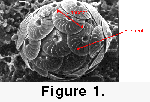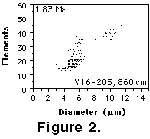REVIEW OF PREVIOUS TAXONOMIC
CONCEPTS AND THE PHYLOGENETIC RECONSTRUCTION OF C. LEPTOPORUS
In order to better explain the construction of the
C. leptoporus animated phylogenetic scenes, a brief summary of the
taxonomic concept and the morphometric measurements that were developed in Knappertsbusch
(2000) is provided below. The motivations of the entire study, descriptions
of core and sample locations, measurement techniques and precision are discussed
in detail in that reference and are not repeated here. The calculations of
numerical ages of all samples follows the integrated chronology of Berggren
et al. (1995) and is also documented in that reference.
 Coccospheres
of Calcidiscus leptoporus (Figure 1)
are covered by circular to sub-circular calcite platelets. On their surfaces
(=distal side) these coccoliths are ornamented by sinistrally imbricated
elements with sinusoidally shaped sutures. Using the diameter of the coccoliths
and the number of elements per cycle in these shields, various authors have
distinguished several morphological variants of C. leptoporus in both
living and fossil assemblages (Bukry
and Bramlette 1969; Janin 1981;
Baumann 1990; Knappertsbusch
et al., 1997). The subspecific, and in some cases the specific, positions of
these morphotypes in the diameter versus elements space are, however, still not
yet firmly established because patterns of accepted variation within these
morphotypes exhibits substantial overlap.
Coccospheres
of Calcidiscus leptoporus (Figure 1)
are covered by circular to sub-circular calcite platelets. On their surfaces
(=distal side) these coccoliths are ornamented by sinistrally imbricated
elements with sinusoidally shaped sutures. Using the diameter of the coccoliths
and the number of elements per cycle in these shields, various authors have
distinguished several morphological variants of C. leptoporus in both
living and fossil assemblages (Bukry
and Bramlette 1969; Janin 1981;
Baumann 1990; Knappertsbusch
et al., 1997). The subspecific, and in some cases the specific, positions of
these morphotypes in the diameter versus elements space are, however, still not
yet firmly established because patterns of accepted variation within these
morphotypes exhibits substantial overlap.  As
a result, additional criteria must be applied for reliable diagnosis. Calcidiscus
macintyrei, for example, which is a very large extinct morphovariant, is
considered a separate species by stratigraphers, whereas other investigators
treated it as an informal morphovariant (Janin,
1981; Knappertsbusch
et al. 1997; Knappertsbusch
2000).
As
a result, additional criteria must be applied for reliable diagnosis. Calcidiscus
macintyrei, for example, which is a very large extinct morphovariant, is
considered a separate species by stratigraphers, whereas other investigators
treated it as an informal morphovariant (Janin,
1981; Knappertsbusch
et al. 1997; Knappertsbusch
2000).
The characterization of C. leptoporus by
coccolith size and number of distal shields was, however, found useful for
morphotype separation in C. leptoporus.  This
distinction was especially clear when contoured bivariate diagrams of coccolith
frequencies were constructed (see example in Figure
2 and Figure 3). Based on this
technique Knappertsbusch
(2000) elaborated a taxonomic scheme with nine morphotypes from a global set
of living, Holocene, and Miocene to Pleistocene assemblages (Figure
4).
This
distinction was especially clear when contoured bivariate diagrams of coccolith
frequencies were constructed (see example in Figure
2 and Figure 3). Based on this
technique Knappertsbusch
(2000) elaborated a taxonomic scheme with nine morphotypes from a global set
of living, Holocene, and Miocene to Pleistocene assemblages (Figure
4).  The
interpretation of the stratigraphic distribution of these morphotypes led to the
putative phylogenetic reconstruction of C. leptoporus from the Miocene to
Recent shown in Figure 5.
The
interpretation of the stratigraphic distribution of these morphotypes led to the
putative phylogenetic reconstruction of C. leptoporus from the Miocene to
Recent shown in Figure 5.
The phylogenetic  reconstruction
obtained in this way was compared with a semi-continuous mathematical data
model, that interpolated between coccolith densities per unit areas of diameter
versus elements (=grid-cells, see Figure 3)
in samples from one time-level to the next. This approach avoided application of
the artificial classification scheme shown in Figure
4 (the details of this model are explained under "Approach 3" and
in Figures 8 and 9 of Knappertsbusch
2000).
reconstruction
obtained in this way was compared with a semi-continuous mathematical data
model, that interpolated between coccolith densities per unit areas of diameter
versus elements (=grid-cells, see Figure 3)
in samples from one time-level to the next. This approach avoided application of
the artificial classification scheme shown in Figure
4 (the details of this model are explained under "Approach 3" and
in Figures 8 and 9 of Knappertsbusch
2000).

 Coccospheres
of Calcidiscus leptoporus (Figure 1)
are covered by circular to sub-circular calcite platelets. On their surfaces
(=distal side) these coccoliths are ornamented by sinistrally imbricated
elements with sinusoidally shaped sutures. Using the diameter of the coccoliths
and the number of elements per cycle in these shields, various authors have
distinguished several morphological variants of C. leptoporus in both
living and fossil assemblages (Bukry
and Bramlette 1969; Janin 1981;
Baumann 1990; Knappertsbusch
et al., 1997). The subspecific, and in some cases the specific, positions of
these morphotypes in the diameter versus elements space are, however, still not
yet firmly established because patterns of accepted variation within these
morphotypes exhibits substantial overlap.
Coccospheres
of Calcidiscus leptoporus (Figure 1)
are covered by circular to sub-circular calcite platelets. On their surfaces
(=distal side) these coccoliths are ornamented by sinistrally imbricated
elements with sinusoidally shaped sutures. Using the diameter of the coccoliths
and the number of elements per cycle in these shields, various authors have
distinguished several morphological variants of C. leptoporus in both
living and fossil assemblages (Bukry
and Bramlette 1969; Janin 1981;
Baumann 1990; Knappertsbusch
et al., 1997). The subspecific, and in some cases the specific, positions of
these morphotypes in the diameter versus elements space are, however, still not
yet firmly established because patterns of accepted variation within these
morphotypes exhibits substantial overlap.  As
a result, additional criteria must be applied for reliable diagnosis. Calcidiscus
macintyrei, for example, which is a very large extinct morphovariant, is
considered a separate species by stratigraphers, whereas other investigators
treated it as an informal morphovariant (Janin,
1981; Knappertsbusch
et al. 1997; Knappertsbusch
2000).
As
a result, additional criteria must be applied for reliable diagnosis. Calcidiscus
macintyrei, for example, which is a very large extinct morphovariant, is
considered a separate species by stratigraphers, whereas other investigators
treated it as an informal morphovariant (Janin,
1981; Knappertsbusch
et al. 1997; Knappertsbusch
2000).

